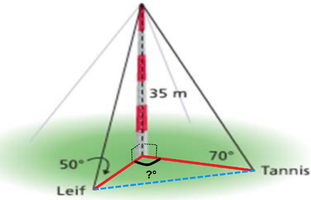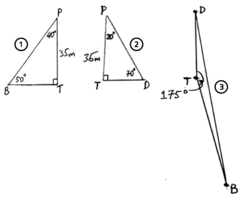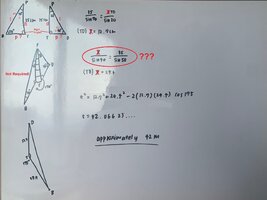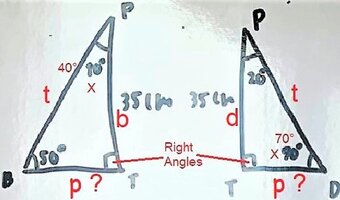A communication tower is 35 m tall. David is due north of the tower and measures the angle of elevation of the top of the tower as 70°. Brenda is on a bearing of 175° from the tower and measures the angle of elevation of the top of the tower as 50° To the nearest metre, determine the distance between Brenda and David.
You are using an out of date browser. It may not display this or other websites correctly.
You should upgrade or use an alternative browser.
You should upgrade or use an alternative browser.
need help sketching diagram! (no answer needed) "A communication tower is 35 m tall...."
- Thread starter senakuny
- Start date
Otis
Elite Member
- Joined
- Apr 22, 2015
- Messages
- 4,414
Hi senakuny. I would draw two, separate right triangles, representing the different angles of elevation with the 35m tower. Label the given measurements. I would also draw a bird's-eye view of the tower, David and Brenda. Those three locations form an obtuse triangle on the ground, and one of its side lengths you're asked to find. The other two side lengths are calculated using the two right-triangle diagrams.
Please upload an image of your attempt, and confirm that "bearing" in your class means degrees clockwise, starting at due north.
[imath]\;[/imath]
Please upload an image of your attempt, and confirm that "bearing" in your class means degrees clockwise, starting at due north.
[imath]\;[/imath]
The Highlander
Full Member
- Joined
- Feb 18, 2022
- Messages
- 937
Hi @senakuny,A communication tower is 35 m tall. David is due north of the tower and measures the angle of elevation of the top of the tower as 70°. Brenda is on a bearing of 175° from the tower* and measures the angle of elevation of the top of the tower as 50° To the nearest metre, determine the distance between Brenda and David. *Surely that should be on "a bearing from North" not from the "tower"??
Below is a nice 'picture' from a very similar problem. Looking at that may help you to understand why @Dr.Peterson is suggesting that you might benefit from three separate sketches.
You need to know the lengths of the two red lines and the (black) angle between them (?°) in order to find the length of the blue (dotted) line.
Hope that helps. ?
Last edited:
Hi senakuny. I would draw two, separate right triangles, representing the different angles of elevation with the 35m tower. Label the given measurements. I would also draw a bird's-eye view of the tower, David and Brenda. Those three locations form an obtuse triangle on the ground, and one of its side lengths you're asked to find. The other two side lengths are calculated using the two right-triangles diagrams.
Please upload an image of your attempt, and confirm that "bearing" in your class means degrees clockwise, starting at due north.
[imath]\;[/imath]
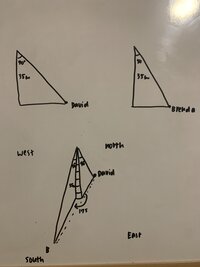
would it be like this? I tried my best?
Last edited:
Hi @senakuny,
Below is a nice 'picture' from a very similar problem. Looking at that may help you to understand why @Dr.Peterson is suggesting that you might benefit from three separate sketches.
You need to know the lengths of the two red lines and the (black) angle between them (?°) in order to find the length of the blue (dotted) line.
Hope that helps. ?
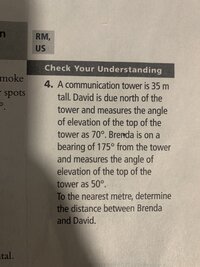
This is the original question and it says "from the tower"? I've uploaded my attempt!
Otis
Elite Member
- Joined
- Apr 22, 2015
- Messages
- 4,414
Yes, except the 70º and 50º angles are mislabeled. See angle of elevation.would it be like this?
[imath]\;[/imath]
The Highlander
Full Member
- Joined
- Feb 18, 2022
- Messages
- 937
Hi again @senakuny,This is the original question and it says "from the tower"? I've uploaded my attempt!
I didn't mean to criticize you, I suspected that was what the question might have said but I suppose we all make mistakes; I see now it was @Otis, not Dr.Peterson, who was posting earlier. My bad.
However, you do really seem to be struggling with this.
I have, therefore, drawn the sketches that I would make for this problem below.
Throughout the above diagrams:-
- T is the base of the tower (at ground level).
- P is the top of the tower (its pinnacle).
- D is the point where David is standing.
- B is the point where Brenda is standing.
You are given the height of the tower (TP) as 35m.
If you were to stand between David and Brenda you would see them looking up at the top of the tower (at an angle of 50° and 70° respectively) and this is represented in the first two sketches.
So David will be the length of DT away from the tower and Brenda will be the length of BT away from it.
You can calculate those lengths using basic right-angled triangle trigonometry (I hope).
The third sketch represents you looking down on the scene (maybe from a helicopter?) and now you see how far away from T (the tower’s base) David is (ie: the length of DT) and also how far Brenda is from T (ie: the length of BT.
However, since you have already calculated the lengths of both BT & DT (from the info. in first two sketches) and you are given the angle between those two lines (∠BTD) as 175°, then you should now be in a position to calculate the length of the side BD using a trigonometric law that I trust you are familiar with?
If you don’t know how to do that (or what law to use), come back and tell us.
If you do know then please (re-)draw your own sketches and show us all your working to determine the distance between David & Brenda to the nearest metre (ie: the length of BD).
Hope to hear from you soon. ?
Hi again @senakuny,
I didn't mean to criticize you, I suspected that was what the question might have said but I suppose we all make mistakes; I see now it was @Otis, not Dr.Peterson, who was posting earlier. My bad.
However, you do really seem to be struggling with this.
I have, therefore, drawn the sketches that I would make for this problem below.
Throughout the above diagrams:-
- T is the base of the tower (at ground level).
- P is the top of the tower (its pinnacle).
- D is the point where David is standing.
- B is the point where Brenda is standing.
You are given the height of the tower (TP) as 35m.
If you were to stand between David and Brenda you would see them looking up at the top of the tower (at an angle of 50° and 70° respectively) and this is represented in the first two sketches.
So David will be the length of DT away from the tower and Brenda will be the length of BT away from it.
You can calculate those lengths using basic right-angled triangle trigonometry (I hope).
The third sketch represents you looking down on the scene (maybe from a helicopter?) and now you see how far away from T (the tower’s base) David is (ie: the length of DT) and also how far Brenda is from T (ie: the length of BT.
However, since you have already calculated the lengths of both BT & DT (from the info. in first two sketches) and you are given the angle between those two lines (∠BTD) as 175°, then you should now be in a position to calculate the length of the side BD using a trigonometric law that I trust you are familiar with?
If you don’t know how to do that (or what law to use), come back and tell us.
If you do know then please (re-)draw your own sketches and show us all your working to determine the distance between David & Brenda to the nearest metre (ie: the length of BD).
Hope to hear from you soon. ?
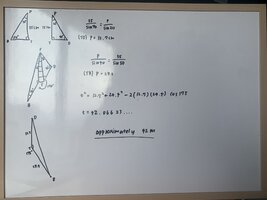
Hi! I got it! Thank you so much!
The Highlander
Full Member
- Joined
- Feb 18, 2022
- Messages
- 937
No, I’m sorry @senakuny, but I’m afraid you haven’t "got it" at all. ??View attachment 35342
Hi! I got it! Thank you so much!
I have marked up your 'board' (in red) with respect to my comments (below it).
Firstly, I asked you to re-draw your sketches and even gave you examples of ‘correct’ ones but yours still aren’t right! The little squares indicate the position of a right angle (at T in both sketches) but you have also marked ∠PDT = 90° which simply isn’t possible in any triangle (where all three angles must add to 180°!). In the other triangle (ΔPBT) your acute angles don’t add to 90 either!
Secondly, P is a point (ie: a 1 dimensional entity that has no length) therefore it is not appropriate to use that (label) in your equations to determine the lengths of the triangles’ bases. You should just have used TD and/or TB alone (instead of putting them in brackets) or, if it was your intention to use a lower case p as a 'label' for the bases (as would be acceptable in line with the conventional naming of triangles’ sides & vertices) then you should have marked the sides as such in your sketches. IMNSHO, to avoid clutter (and the possibility of confusion between upper & lower case P’s) it would be preferable just to name the line segments by the vertices at each end. Thus, stick to TD & TB; don’t include both them and a single letter!
Thirdly, (and most importantly!) you have got your use of the basic trigonometry all wrong! There was no place for the Sine Ratio in the initial calculations! And why have you got fractions on both side of your equations??? ?
There should only be three terms in these equations: two sides and a trig ratio! ?
That means you cannot arrive at the correct final answer, having got the lengths TD & TB wrong at the outset. ?
So, I’m afraid I must urge you, once again, to go back to your 'drawing board' (?) once more.
Please re-draw your sketches (correctly this time?) and have a think about what the correct ratio to use is when calculating lengths TD & TB.
If you’re not sure which one to use then please study my ‘crib sheet’ (below) to help you decide.
Once you’ve done that, please re-submit your work and I (or someone else in here) will look at it and let you know whether it’s right this time. OK? ?

Last edited:
Dr.Peterson
Elite Member
- Joined
- Nov 12, 2017
- Messages
- 16,092
I think you've misread the angle, which is too small to read accurately.The little squares indicate the position of a right angle (at T in both sketches) but you have also marked ∠PDT = 90° which simply isn’t possible in any triangle
I think he's using the Law of Sines, which isn't needed for a right triangle, but isn't technically wrong, either.There was no place for the Sine Ratio in the initial calculations! And why have you got fractions on both side of your equations?
I haven't looked at everything carefully yet.
The Highlander
Full Member
- Joined
- Feb 18, 2022
- Messages
- 937
Zooming in, they definitely look wrong but it seems they may just be badly written right enough. ?I think you've misread the angle, which is too small to read accurately.
It looks like you (& s/he) are quite right!I think he's using the Law of Sines, which isn't needed for a right triangle, but isn't technically wrong, either.
I did 'advise' him/her to use basic right-angled triangle trigonometry to calculate the base lengths of the triangles (in Post #7) which is why I was surprised to see his/her equations in that form and it simply didn't occur to me that the Sine Law was being used. I didn't do any calculations myself (using "p"=35tanθ) or I would have seen s/he was getting the "right" answers and given it some further thought.
Some intermediate working would have made things clearer!
Indeed, it's always a good idea to do the calculations yourself (which I didn't bother to do before composing my last post; could have saved myself a lot of time & bother!?)I haven't looked at everything carefully yet.
So, it looks like your answers are, indeed, correct, @senakuny, if just a little messy (& incomplete; working at each stage should always be shown!. ?
One (last) thought, however, your answer should just be 42m (not "approximately 42m") as you were specifically told to provide your answer to the nearest metre. ?
Thanks to @Dr.Peterson for pointing out the bits I missed. ??
Last edited:
Otis
Elite Member
- Joined
- Apr 22, 2015
- Messages
- 4,414
Hi senakuny. Good for you! Your answer and work setting up the Law of Cosines matches mine. I found the two side lengths from the right triangles differently. We know that tan(x)=Opposite/Adjacent:I got it!
tan(70º) = 35/Adjacent
Adjacent = 35/tan(70º) ≈ 12.739
[imath]\;[/imath]
Otis
Elite Member
- Joined
- Apr 22, 2015
- Messages
- 4,414
you do really seem to be struggling with this.
Talking to yourself?I’m afraid you haven’t "got it" at all.
[imath]\;[/imath]
I was definitely in a rash, and my work is not fully detailed and messy? I just thought it was all good since my answer matched with my answer key! Thanks for your explanation although, it helped me a lot!!Zooming in, they definitely look wrong but it seems they may just be badly written right enough. ?
It looks like you (& s/he) are quite right!
I did 'advise' him/her to use basic right-angled triangle trigonometry to calculate the base lengths of the triangles (in Post #7) which is why I was surprised to see his/her equations in that form and it simply didn't occur to me that the Sine Law was being used. I didn't do any calculations myself (using "p"=35tanθ) or I would have seen s/he was getting the "right" answers and given it some further thought.
Some intermediate working would have made things clearer!
Indeed, it's always a good idea to do the calculations yourself (which I didn't bother to do before composing my last post; could have saved myself a lot of time & bother!?)
So, it looks like your answers are, indeed, correct, @senakuny, if just a little messy (& incomplete; working at each stage should always be shown!. ?
Thanks to @Dr.Peterson for pointing out the bits I missed. ??
The Highlander
Full Member
- Joined
- Feb 18, 2022
- Messages
- 937
You really enjoyed that didn't you? ?Talking to yourself?
[imath]\;[/imath]
'Nuff said.

